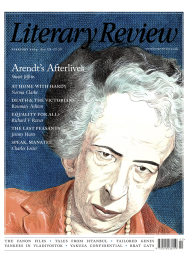C P W Gammell
The Prophet & the Pretenders
The House Divided: Sunni, Shia and the Making of the Middle East
By Barnaby Rogerson
Barnaby Rogerson’s new book has come along at precisely the right time. The House Divided, a vast history of the Sunni–Shia divide, is a balanced, sweeping, hugely ambitious work that delves into the long and tangled roots of the modern Middle East. Rogerson examines both what divides Sunni, followers of the ‘way’ of Muhammad, and Shia, devoted to Ali, the Prophet Muhammad’s son-in-law, and what binds them. It is also a study of geopolitics, history and how societies and empires rise and fall. Despite occasionally feeling chivvied along at the expense of important detail, the reader is left better informed about a large swathe of global history.
Following Muhammad’s death in 632, disputes rumbled on between two parties of his followers: Sunni and Shia. These tensions culminated in the death of Husayn ibn Ali, the grandson of the Prophet, at the Battle of Kerbala in 680 while fighting the forces of the Umayyad caliph Yazid I. After the battle, Rogerson writes, ‘In Mecca, the Kaaba was a burned-out ruin and in a neglected field at Kerbala the headless corpses of the murdered family of the prophet of God lay buried. It was as if the things of this earth had been won but in the process the kingdom of heaven had been forgotten.’
Rogerson doesn’t begin his account here, however. He takes the reader back to the start of Islam, before the split, to Muhammad’s early life in Mecca, where he dispensed wisdom among his family and followers. This didn’t relate to temporal power or worldly success, but rather to ‘how all should

Sign Up to our newsletter
Receive free articles, highlights from the archive, news, details of prizes, and much more.@Lit_Review
Follow Literary Review on Twitter
Twitter Feed
It wasn’t until 1825 that Pepys’s diary became available for the first time. How it was eventually decrypted and published is a story of subterfuge and duplicity.
Kate Loveman tells the tale.
Kate Loveman - Publishing Pepys
Kate Loveman: Publishing Pepys
literaryreview.co.uk
Arthur Christopher Benson was a pillar of the Edwardian establishment. He was supremely well connected. As his newly published diaries reveal, he was also riotously indiscreet.
Piers Brendon compares Benson’s journals to others from the 20th century.
Piers Brendon - Land of Dopes & Tories
Piers Brendon: Land of Dopes & Tories - The Benson Diaries: Selections from the Diary of Arthur Christopher Benson by Eamon Duffy & Ronald Hyam (edd)
literaryreview.co.uk
Of the siblings Gwen and Augustus John, it is Augustus who has commanded most attention from collectors and connoisseurs.
Was he really the finer artist, asks Tanya Harrod, or is it time Gwen emerged from her brother’s shadow?
Tanya Harrod - Cut from the Same Canvas
Tanya Harrod: Cut from the Same Canvas - Artists, Siblings, Visionaries: The Lives and Loves of Gwen and Augustus John by Judith Mackrell
literaryreview.co.uk